Crop rotation is the practice of growing a series of different types of crops in the same area in a sequence. It helps in reducing soil erosion and increases soil fertility and crop yield.
This datasheet includes definitation, advantages of crop rotation and examples of several crop rotation plans.
Introduction
Crop rotation is a practice of growing different crops on the same land in a regular recurring sequence. It means the planned order of specific crops planted on the same field. It also means that the succeeding crop belongs to a different family than the previous one. The planned rotation may vary from 2 or 3 years to longer period. Rotation of crops is not only necessary to offer a diverse "diet" to the soil microorganisms, but as they are rooting at different soil depths hence are capable to explore the different soil layers for nutrients. Nutrients that have been leached to deeper layers and that are no longer available for the commercial crop can be "recycled" by the crops in rotation. This way the rotation crops function as biological pumps. Furthermore, a diversity of crops in rotation leads to a diverse soil flora and fauna, as the roots excrete different organicsubstances that attract different types of bacteria and fungi, which in turn, play an important role in the transformation of these substances into plant available nutrients. The most important reason of crop rotation is to hinder the development of weeds, arthropod pests and short-persistent soil-borne diseases by reducing their population levels in the soil.
Many of the pests and diseases that plague vegetable plants live in the soil. A common source of soil-borne problems is the seedbed. If a farmer has a problem with his or her seedbed it may mean that plants are infected/infested very early and never have a chance to thrive. Often seedbeds are drenched with pesticide to prevent this.
Another and more common source of soil-borne pest and disease infection is the main production field itself. If a farmer grows crops in the same category year after year on the same land an almost certain result is a build up of pest and disease problems.
Effects of crop rotation
- Higher diversity in plant production and thus in human and livestock nutrition
- Reduction and reduced risk of pest and weed infestations
- Greater distribution of channels or biopores created by diverse roots (various form, size and depths)
- Better distribution of water and nutrients through the soil profile
- Exploration for nutrients and water of the whole soil profile by roots of many different plant species resulting in an optimal use of the available nutrients and water
- Increased nitrogen fixation through certain plant-soil biota symbionts and improved balance of N/P/K from both organic and mineral sources
- Increased humus formation
Means and practices of crop rotation
- Crop rotation plan/design should be guided by the set objectives i.e. food and fodder production (grain, leaf, stalks), residue production, pest and weed control, nutrient uptake and biological subsurface mixing/cultivation, etc.
- For better result; appropriate/improved seeds as well as high residue production of above ground and below-ground biomass.
Advantages or benefits of crop rotation
- It improves the soil structure and reduces depletion/erosion: Some crops have strong, deep roots. They can break up hardpans, and tap moisture and nutrients from deep in the soil. Others have many fine, shallow roots. They tap nutrients near the surface and bind the soil. They form many tiny holes so that air and water can get into the soil.
- It increases soil fertility: Legumes (such as groundnuts and beans) fix nitrogen in the soil. When their green parts and roots rot, this nitrogen can be used by other crops such as maize. The result is higher, more stable yields, without the need to apply expensive inorganic fertilisers.
- It helps control weeds, pests and diseases hence reduce reliance on synthetic chemicals: Planting the same crop season after season encourages certain weeds, insects and diseases. Planting different crops breaks their life cycle and prevents them from multiplying.
- It produces different types of output: Growing a mix of grain, beans, vegetables and fodder means a more varied diet and more types of produce to sell.
- It reduces risk: A single crop may fail because of drought. It may be attacked by pests. Or its market price may be low when time comes to sell it. Producing several different crops reduces these risks.
- Crop rotation may also replace ploughing the soil since it helps aerate, the soil, recycles nutrients, and helps control weeds, pests and diseases hence perfectly fitting within the ideals of conservation agriculture.
- Intercropping, strip cropping and relay cropping bring many of the same advantages as rotation. Even so, it is a good idea to rotate crops even if you use these approaches.
Which crop should not be planted together or in rotation
The table below indicates which crops are in the groups that suffer from the same pest and disease problems and which should therefore not be planted in rotation.
Table; Crops in the same group should not be planted in rotation
 |
|
© University of Vermont Extension website
|
Record keeping is important
A well kept field record book is a great help in remembering which crop has in the past been grown in a particular plot within the field or farm. This is useful especially if the records also show past incidents of plant pests or diseases in each plot in the farm.
Most importantly is the role of crop rotation in the management of pest and disease problems in the soil. These problems in the soil can build up during the life of a susceptible crop. If the same crop or a similar type belonging to the same family is grown in the same field, it will suffer from the accumulated pests and diseases from the previous crop(s) and may not grow well. This can be avoided if the soil is left fallow (not cropped) for a while, or a different crop is planted which is tolerant or resistant to the particular pest or disease. Better still is to plant a crop from a different family which will not share a same complex of pests and diseases. This will result in decline of soil problems and the original crop can be grown successfully again.
Rotations to manage weeds
Rotations are also used to control weeds. Crops such as Irish potatoes and other root crops may generally have more weeds than cereal crops because there are good selective herbicides for cereal crops, so rotating with a crop which allows easy weed control gives farmers an opportunity to reduce the build up of weeds. Interestingly, before herbicides were introduced the cereals were generally troubled by weeds more than the root crops because mechanical weeding was easier in the latter.
Rotations to manage nematodes
A special example of rotation is used to manage nematodes, which can be a problem in light sandy soils. Some crops are less suitable hosts for the nematodes. Nematode numbers actually reduce through the season if such crops are planted. This allows the susceptible crop to be grown again in the soil after one or two years.
Selecting the right crops and crop combinations
The success of conservation agriculture lies on proper and good crop rotation plan. Different plant species or even varieties have different needs for nutrients, light, water, temperature and air. When one of these basic needs is not met, the plant will be stressed and will not grow properly. Selecting crop rotation varieties is therefore a very important exercise which a farmer needs to undertake. The following considerations will however guide the farmer into making the best decision:
What crops do you currently produce?
Various crops produce many different things: food, fodder, firewood, fence poles, thatch and medicines. The farmer's interest and objective with that particular crop is a critical factor.
Will it grow well?
This depends on many things: rainfall, temperature, soil characteristics, soil fertility, presence of pests and diseases. Therefore, choose crops that are adapted to soils and climate of that particular area.
What inputs are needed?
How much work does it take to grow the crop? Can you get seed? Do you have the right implements/tools? Do you need other inputs, such as fertilisers or pesticides?
What are the roots like?
Tall cereals (millet, maize, sorghum), finger millets and some legumes (e.g., pigeon pea and Dolichos lablab) have strong roots that penetrate deep into the soil? up to 1.2 m. Their roots improve the soil structure and porosity, so are a good choice if the soil is compacted.
Does it improve the soil fertility?
Legumes improve the soil fertility by fixing nitrogen from the air. They use part of it for their own needs, and leave the rest in the soil. Cereals and other plants can use this nitrogen if they are intercropped with the legumes, or if they are grown as the next crop in the rotation.
Does it cover the soil well?
Tall cereals do not cover the soil well because they have upright leaves and they are planted far apart. Short grasses like Brachiaria (signal grass), Cenchrus (sandbur), and Andropogon (beard grass) and legumes (e.g. cowpea, beans, groundnut, lablab, etc) cover the soil quickly after they are planted, protecting it from erosion. When their main use is to provide cover, we call them cover crops. If their main use is to provide food, we call them food legumes (beans, groundnuts).
Does it work with other crops?
Try to find combinations of crops that complement each other well. For example, cereals grow well with legumes (either food legumes or cover crops): the cereals benefit from the nitrogen fixed by the legume. Two different legumes or two different cereals do not usually work well together. If you have problems with Striga in your field, you may want to grow trap crops such as Crotalaria or Tephrosia to encourage the Striga to germinate and die when they do not find any suitable plants (such as maize or sorghum).
Does market exist for the crop?
Market availability and access is critical for motivation of the farmers for continued production of any particular cover crop. In fact it is for this reason that cover crops such as common beans, D.lablab, pigeon peas, cowpeas, pumpkin and many others are quite common and very popular amongst the farmers compared to cover crops such as Mucuna, Canavalia, Desmodium etc.
How to choose a crop rotation
What crops should you plant next year, and the year after that? The following tips provide guidance!
Know the family where your crops belong to make sure that you plant on the next cropping season a crop that belongs to a different family to the previous one. The table below provides various crop families and their common names.
Table: Crop families and their common names
| Family | Common names |
| Allium | Chive, garlic, leek, onion, shallot |
| Cucurbit (Gourd family) | Bitter gourd, bottle gourd, chayote cucumber, ivy gourd, luffa gourd, melons pumpkins, snake gourd, squash, wax gourd |
| Crucifer (Brassica) | Bok choy (petchay), broccoli, brussels sprouts, cabbage, Chinese cabbage, cauliflower, collard, kale, kohlrabi, mustard, radish, turnip, watercress |
| Legume | Common beans, black bean, broad bean (Fava), clover, cowpea, garbanzo, hyacinth bean, kidney bean, Lima bean, lintel, mungbean, peanut, pigeon pea, pinto bean, runner bean, snap pea, snow pea, soybean, string bean, white bean |
| Aster | Lettuce, artichoke |
| Solanaceous (Nightshade family) | Potato, tomato, pepper, eggplant |
| Grains and cereals | Corn, rice, sorghum, wheat, oat, barley, millet |
| Carrot family | Carrot, celery, dill, parsnip, parsley |
| Root crops | Cassava, sweet potato, taro, yam, water chestnut |
| Mallow family | Cotton, okra |
1. Make a list of the crops you want to grow by also taking into consideration the market's demand of your produce. For example, plant leafy vegetable on the first cropping season, next fruit vegetables, then root crops, then legumes, then small grains
2. Grow legumes before grains or cereals
3. A map of the shamba; Draft the map of the entire farm showing the different fields in relation to the home and slopes of the land as illustrated in the example below:
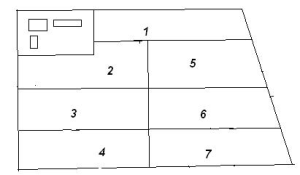 |
| Buildings are in the top left corner and the land possibly sloping downwards towards field no.7. The borders between fields on sloping land have contour strips or trees, but the main thing in crop rotation is that the disease prone crops are rotated with resistant ones to prevent problems building up in the soil. |
|
© Anne Bruntse, BioVision
|
Aromatic herbs such as Dania are not in this list but they combine very well with most other vegetable crops and can help repel insect pests. See crop rotation example no.1 below.
Fodder crops (for animal feed) such as napier or boma grass are considered important crops by many farmers where dairy cows are kept under zero grazing. They are also a very good soil stabiliser as the roots really hold the soil together. Grasses in mixture with legumes such as desmodium and napier and clover and boma grass can act as a major soil improver if left for several years while given good manure. Also a slurry of the napier, and animal droppings on the boma grass constitutes a good soil improver. Grass must not be over grazed or cut too often. Excess napier should be cut and left as a green manure (soil improver). Napier grass can also be planted on the contour lines to reduce soil erosion.
Vegetables are often grown as cash crops as well as for home consumption. One crop that has gained popularity in high altitude areas is the "Irish" potato. It is an imported crop from South America and it is doing very well in East African highlands. It is now rated second to maize as a 'staple' in Kenya.
However, it is not fitting well in rotation patterns where tomato features as a cash crop as both belonging to the same family and share a same complex of pests and diseases.
Vegetable crops need crop rotation and field sanitation. This means volunteer plants need to be removed from fields to minimise the incidence of diseases and pests. Pests such as root-knot nematodes are the biggest problem in intensive vegetable production systems, which is the case presently in most smallholder farming scenarios, particularly, in sub-Saharan African countries. For example, in tomato production where root-knot nematodes are a problem, crop rotation pattern recommended entails a rotation in sequence with
- brassicas,
- cassava, cereals, garlic, leak or onions and
- back to tomatoes.
It ensures tomatoes or its relatives (e.g. Irish potatoes, eggplants, capsicums, etc) and other susceptible vegetable crops such as beetroot, beans, carrots, celery, okra, peas, etc are excluded in the planting plan, and thereby, reduction in nematode population in the soil.
In lower altitudes, sweet potato and cassava take the place of the "Irish" potatoes in the crop rotation and also these have their soil problems and should be rotated between different fields. Sweet potato weevils and eggs survive in the soil for a long time, and African cassava mosaic virus has a great chance of multiplying if left in the same field for too long.
The brassica family also have soil-borne problems, and should always be shifted around in the fields, getting as many growing seasons between two crops as possible. On the other hand brassicas clean the field from potato/tomato problems, so are very good crops to grow before a potato or tomato crop.
Assuming that the farm on the above field map has two grass fields, field no. 1 and field no 7, (remember 1 acre of plain napier grass can feed 1 grade cow, but 1 acre of napier intercropped with desmodium can feed 2 to 3 grade cows), there are 5 plots left for other crops. The family might need 3 plots for grains for home consumption. This would leave 2 fields for cash crops.
In order to optimise yields from the land, it is recommended all the grain fields should have legumes interplanted. This is also applicable when growing vegetables.
Most vegetable small-scale farmers in Africa identify 4 categories of vegetables; these are not overall botanically based but on their diversity in nutrient requirements. Cereals are also included in the rotation scheme with the vegetables. This concept meets the prerequisites of crop rotation:
a) Leaf crops (broccoli, cabbages, cauliflowers, kales, spinach, etc). They need more nutrients than the other vegetables.
b) Fruit crops (chillies, egg plants, peppers, tomatoes, etc). They need a considerable amount on nutrients but not so much as 'leaf' crops.
c) Root crops (carrots, beet roots, potatoes, onions, radishes, turnips, etc). They need less nutrients compared with leaf and fruit crops.
d) Legumes (beans, chickpeas, cowpeas, grams, peas, pigeon peas, etc). Their additional benefit is fixing atmospheric nitrogen into the soil.
e) Cereals (maize, millets, sorghum etc)
Small-scale farmers often grow vegetables from different families, as above stated, in different plots each season. They call it crop rotation. Their reasons are logically based through experience - nutrients need by different vegetables and prevention of soil-borne pests and diseases common in vegetable families.
See crop rotation example no.2 below.
Remember:
Cabbages or plants of the brassica family are good to plant before and after potatoes, tomatoes and other of Solanaceae family, to prevent build up of root-knot nematodes and bacterial wilt.
Weed out volunteer plants or any sick looking plants.
Heavy feeding plants should be planted (and fed by good compost or other organic material) before less demanding plants. The less demanding plants can then benefit from left over manure from the heavy feeders.
All crops harvested remove nutrients from the soil. Make sure these nutrients are replenished. All legumes have the ability to fix nitrogen from the atmosphere, but some are better than others. The best green manurelegumes for East Africa are listed under green manure.
East Africa also has very many species of nitrogen fixing trees with multiple uses, which can be used for alley cropping etc - see Agro-forestry. These trees can provide fuel wood, animal feed, fruits etc as well as farm products.
Examples of crop rotations
Example 1
The below rotation patterns are targeted at dairy production and are applicable for highland areas in Kenya.
First season
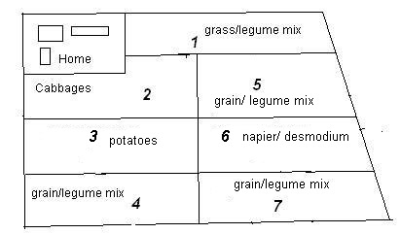 |
| Crop rotation schedule |
|
© Anne Bruntse, BioVision
|
The first season, we shall plant cabbages in field no. 2. Then field no. 3 will have potatoes. Fields 4 and 5 can have grains, and field no.6 napier grass or desmodium.
Second season
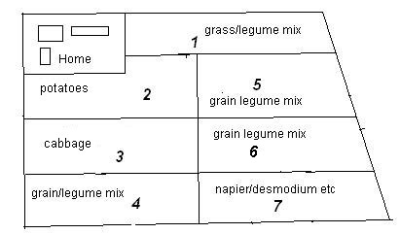 |
| Crop rotation schedule |
|
© Anne Bruntse, BioVision
|
Next season rotate the crops (leaving the fodder crops for some years). Field no. 2 will then have potatoes (or tomatoes etc). Growing cabbages before potatoes (or tomatoes) and chopping unused leaves finely into the soil, greatly helps reduce potato (or tomato) problems. Field no. 3 will have cabbages and fields no. 4, 5 and 6 a grain/ legume mixture.
Third season
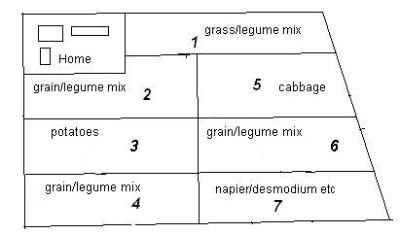 |
| Crop rotation schedule |
|
© Anne Bruntse, BioVision
|
For the third season field no. 2 will have grain/legume mixture, field no. 3 will have potatoes, field no. 5 cabbages or broccoli, etc.
After some years the grass/napier will need to be replanted. Simply move the grass to field no. 2 and 6 and continue the old system of rotation.
It is beneficial, to have as many legumes in the crop rotation as possible. Not only do they provide good protein for people and animals, they also help fixing nitrogen from the atmosphere.
The vegetable plots can also be split or be replaced by other cash crops but the principle remains the same. Rotate sensitive crops that tend to build up soil problems, and uproot volunteers of plants that are able to carry diseases and pest to new crops.
Example 2
This example of a single crop rotation is used by a majority of small-scale vegetable farmers in a year constituting 3 seasons of 4 months each:
First season:
Plot 1: Maize / garlic / onions / or leeks
Plot 2: Eggplant / chillies / potato / or tomato
Plot 3: Broccoli / cabbage / cauliflower / or kale
Plot 4: Beans / cowpeas / grams / or peas
Second season:
Plot 1: Beans / cowpeas / grams or peas
Plot 2: Broccoli / cabbage / cauliflower / or kale
Plot 3: Eggplant / chillies / potato / or tomato
Plot 4: Maize / garlic / onions / or leeks
Third season:
Plot 1: Broccoli / cabbage / cauliflower / or kale
Plot 2: Beans / cowpeas / grams / or peas
Plot 3: Maize / garlic / onions / or leeks
Plot 4: Eggplant / chillies / potato / or tomato
Fourth season
Plot 1: Eggplant / chillies / potato / or tomato
Plot 2: Maize / garlic / onions / or leeks
Plot 3: Beans / cowpeas / grams / or peas
Plot 4: Broccoli / cabbage / cauliflower / or kale
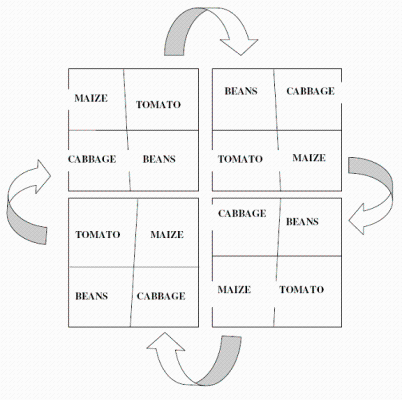 |
| Crop rotation schedule |
|
© A. Seif, icipe
|
Information Source Links
- Aglearn.net, the Network for Sustainable Agriculture, Thailand. Vegetable IPM Course. www.aglearn.net
- Berold, R., C. Caine, D. Cooper, B. Cousins and S. Roberts (1998). People's Farming Workbook. 2nd. Edition. David Philip Publishers (Pty) Ltd., 208 Werdmuller Centre, Claremont, 7708. ISBN: 0 86486 431 0
- CAB International (2005). Crop Protection Compendium, 2005 Edition, Wallingford, UK. www.cabi.org
- Dobson, H., Cooper, J., Manyangarirwa, W., Karuma, J. and W. Chiimba (2002). Integrated Vegetable Pest Management - Safe and Sustainable Protection of Small-Scale Brassicas and Tomatoes. Natural Resources Institute, University of Greenwich, Kent, UK. ISBN: 0-85954-536-9
- Sustainable Agriculture Extension Manual for Eastern and Southern Africa. Available online at www.iirr.org
- Njoroge, J.W. and Manu, C. (Eds)(1999). Organic Farming. A textbook for Post-Secondary Education. Published by Kenya Institute of Organic Farming (KIOF). ISBN 9966-9977-1-7
- Varela, A.M., Seif, A.A. and B. Loehr (2003). A Guide to IPM in Tomato Production in Eastern and Southern Africa. ICIPE Science Press, Nairobi, Kenya. ISBN: 92 9064 149 5
- IIRR and ACT (2005). Conservation agriculture: A manual for farmersand extension workers in Africa. International Institute of Rural Reconstruction, Nairobi; African Conservation Tillage Network, Harare. ISBN 9966-9705-9-2
- Baudeon, F.; Mwanza, H. M.; Triomphe, B; Bwalya, M (2007). Conservation agriculture in Zambia: a case study of Southern Province. Nairobi. African Conservation Tillage Network, Centre de Coopération Internationale de Recherche Agronomique pour le Développement, Food and Agriculture Organization of the United Nations. ISBN: 9966-7219-3-2
- Nyende, P; Nyakuni, A; Opio, J. P; Odogola, W (2007). Conservation agriculture: a Uganda case study. Nairobi. African Conservation Tillage Network, Centre de Coopération Internationale de Recherche Agronomique pour le Développement, Food and Agriculture Organization of the United Nations. ISBN: 9966-7219-2-4
- Shetto, R.; Owenya, M., (eds.) (2007). Conservation agriculture as practised in Tanzania:three case studies. Nairobi. African Conservation Tillage Network, Centre de Coopération Internationale de Recherche Agronomique pour le Développement, Food and Agriculture Organization of the United Nations. ISBN: 9966-7219-4-0
- Kaumbutho P., Kienzle J., (eds). (2007). Conservation agriculture as practised in Kenya: two case studies. Nairobi. African Conservation Tillage Network, Centre de Coopération Internationale de Recherche Agronomique pour le Développement, Food and Agriculture Organization of the United Nations. ISBN: 9966-7219-0-8
